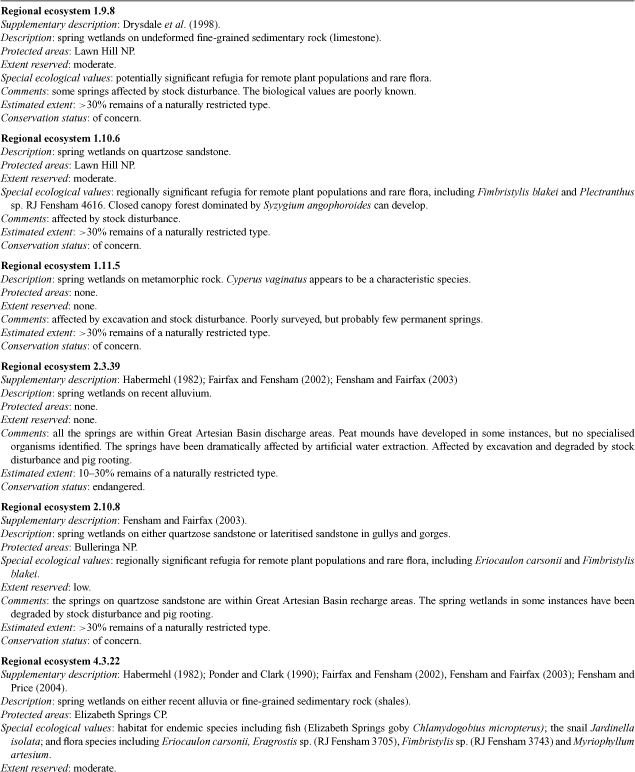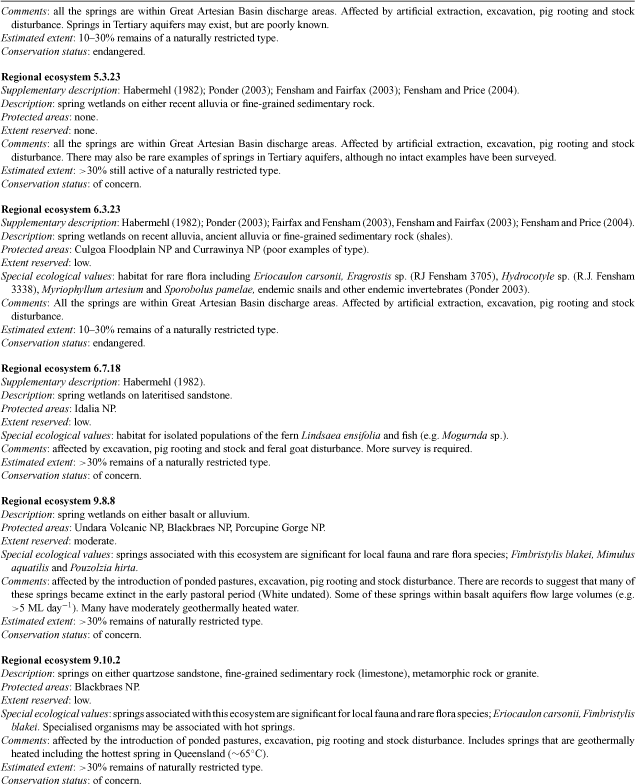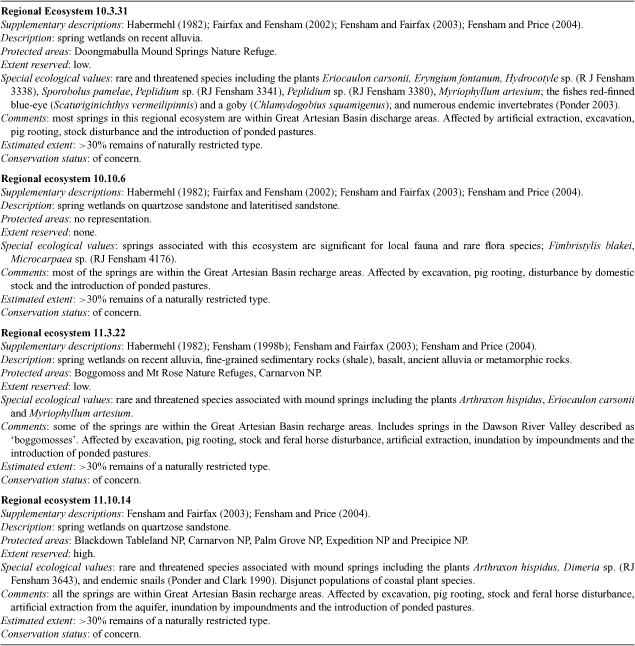Spring wetlands in seasonally arid Queensland: floristics, environmental relations, classification and conservation values
R. J. Fensham A B , R. J. Fairfax A and P. R. Sharpe AA Queensland Herbarium, Environmental Protection Agency, Mt Coot-tha Road, Toowong, Qld 4066, Australia.
B Corresponding author. Email: Rod.Fensham@epa.qld.gov.au
Australian Journal of Botany 52(5) 583-595 https://doi.org/10.1071/BT03171
Submitted: 24 November 2003 Accepted: 14 May 2004 Published: 25 October 2004
Abstract
The vegetation and environmental setting of permanent spring wetlands are described from a survey of 269 spring complexes throughout seasonally arid Queensland. Wetlands associated with springs in the western and southern discharge areas of the Great Artesian Basin are floristically distinct from other spring wetlands. Ordination analysis suggests that the biogeographic regions and the broad geological substrates that support spring wetlands provide a meaningful representation of floristic range. An existing classificatory system that defines ‘regional ecosystems’ on the basis of the biogeographic region and broad geological substrate is adopted to define 15 spring-wetland types in seasonally arid Queensland. The conservation value of the springs is assessed by a scheme that weights plant species populations on the basis of their endemicity and isolation from other populations, demonstrating that both Great Artesian Basin and non-Great Artesian Basin springs have similar conservation values.
Acknowledgments
This project was partly funded by the Threatened Species Program, Environment Australia. The grant was administered by Brigitta Wimmer and her efficiency and patience is gratefully acknowledged. Ian Cowie is thanked for providing specimen data, Robin and Ernest Bassingthwaighte for supplying historical family records, Mike Archer for helicopter support, the landholders for allowing us access and the reviewers for valuable comments on the manuscript.
Fairfax RJ, Fensham RJ
(2002) In the footsteps of J. Alfred Griffiths: a cataclysmic history of Great Artesian Basin springs in Queensland. Australian Geographical Studies 40, 210–230.
| Crossref | GoogleScholarGoogle Scholar |

Fairfax RJ, Fensham RJ
(2003) Great Artesian Basin springs in southern Queensland 1911–2000. Memoirs of the Queensland Museum 49, 285–293.

Faith DP, Norris RH
(1989) Correlation of environmental variables with patterns of distribution and abundance of common and rare freshwater macroinvertebrates. Biological Conservation 50, 77–98.
| Crossref | GoogleScholarGoogle Scholar |

Fensham RJ
(1995) Floristics and environmental relations of inland dry rainforest in north Queensland, Australia. Journal of Biogeography 22, 1047–1063.

Fensham RJ
(1998a) The grassy vegetation of the Darling Downs, south-eastern Queensland, Australia. Floristics and grazing effects. Biological Conservation 84, 301–310.
| Crossref | GoogleScholarGoogle Scholar |

Fensham RJ
(1998b) Mound springs in the Dawson River Valley, Queensland. Vegetation-environment relations and consequences of a proposed impoundment on botanical values. Pacific Conservation Biology 4, 42–54.

Fensham RJ
(1999) Native grasslands of the Central Highlands, Queensland, Australia. Floristics, regional context and conservation. Rangeland Journal 21, 82–103.

Fensham RJ, Fairfax RJ
(2003) Spring wetlands of the Great Artesian Basin, Queensland, Australia. Wetland Ecology and Management 11, 343–362.
| Crossref | GoogleScholarGoogle Scholar |

Fensham RJ, Price RJ
(2004) Ranking spring wetlands in the Great Artesian Basin of Australia using endemicity and isolation of plant species. Biological Conservation 119, 41–50.
| Crossref | GoogleScholarGoogle Scholar |

Kantvilas G, Minchin PR
(1989) An analysis of epiphytic lichen communities in Tasmanian cool temperate rainforest. Vegetatio 84, 99–112.

Ponder WF
(2003) Endemic aquatic macro-invertebrates of artesian springs of the Great Artesian Basin—progress and future directions. Records of the South Australian Museum Monograph Series 7, 101–110.

Ponder WF, Clark GA
(1990) A radiation of hydrobiid snails in threatened artesian springs in western Queensland. Records of the Australian Museum 42, 301–363.

Russell-Smith J
(1991) Classification, species richness, and environmental relations of monsoon rain forest in northern Australia. Journal of Vegetation Science 2, 259–278.

Wilson BA,
Neldner VJ, Accad A
(2002) The extent and status of remnant vegetation in Queensland and its implications for statewide vegetation management and legislation. Rangeland Journal 24, 6–35.


|

|

|


